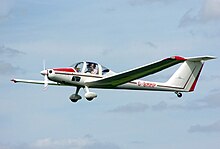T-tail
This article needs additional citations for verification. (December 2007) |




A T-tail is an empennage configuration in which the tailplane is mounted to the top of the fin. The arrangement looks like the capital letter T, hence the name. The T-tail differs from the standard configuration in which the tailplane is mounted to the fuselage at the base of the fin.
Advantages[]
The tailplane is often out of the disturbed airflow behind the wing and fuselage, giving smoother airflow over the elevators, which reduces drag.[citation needed]
This configuration may reduce pitch control effectiveness if the elevators are outside the propeller slipstream, or improve it for many transsonic aircraft because it isn't in disturbed air behind the fuselage, particularly at moderate angles of attack. For flight at high angles of attack, an elevator mounted below the wing is preferred as it isn't blanked by disturbed air from the wings. An aircraft with a T-tail may be easier to recover from a spin, as the elevator is not in a position to block airflow over the rudder, which would make it ineffective, as can happen if the horizontal tail is directly below the fin and rudder.[1]
The T-tail increases the effective aspect ratio of the fin because of 'end plate' effect, where proximity of a perpendicular surface (the horizontal tail and the fuselage in this case) improve aerodynamic efficiency because of reduced air pressure losses over the capped ends of the lifting surface, which in turn provides the same effect of the fin having a higher and more efficient aspect ratio.[2] There is also slightly less drag from airflow around the rudder interfering with airflow over the elevators, compared to a cruciform tail.[citation needed]
T-tails may also be used to increase clearance at the rear of a cargo aircraft such as the Boeing C-17 Globemaster to reduce the chance of the tail being hit while loading or unloading the aircraft.[citation needed]
Disadvantages[]
The aircraft may be prone to stalls at high angles of attack, when airflow over the tailplane and elevators is blanked by the wings [3] The American McDonnell F-101 Voodoo jet fighter suffered from this problem.[citation needed]
The vertical stabilizer must be made stronger (and therefore heavier) to support the weight of the tailplane.[citation needed] Many large aircraft can have the fin and rudder fold to reduce height in hangars, however this generally isn't feasible or useful if there is a T-tail.
The T-tail configuration can also cause maintenance problems. The control runs to the elevators are more complex, and the surfaces are more difficult to inspect from the ground. The loss of Alaska Airlines Flight 261 was attributed to lax maintenance of the T-tail.[citation needed]
Adoption[]
The T-tail is very common on aircraft with engines mounted in nacelles on a high-winged aircraft or on aircraft with the engines mounted on the rear of the fuselage, as it keeps the tail clear of the jet exhaust.
These layouts are often found in military transport aircraft - such as the Ilyushin Il-76, Airbus A400M and the Boeing C-17 Globemaster III - and regional airliners and business jets such as the Pilatus PC-12, Beechcraft Super King Air, Embraer ERJ, British Aerospace 146, and Learjet and Gulfstream families.
It is rarely seen in combat aircraft, although the Gloster Javelin, McDonnell F-101 Voodoo, and Lockheed F-104 Starfighter interceptors all sported T-tails, as did the Blackburn Buccaneer attack aircraft.
See also[]
- Cruciform tail
- Pelikan tail
- Twin tail
- V-tail
- Hans Multhopp, a pioneer user of the T-Tail concept near World War II's end
References[]
- ^ "Summary of spin technology as related to light general-aviation airplanes" (PDF). December 1971. Cite journal requires
|journal=(help) - ^ Hoerner and Borst, Fluid Dynamic Lift, Directional Characteristics, T-tail page 13-11
- ^ "Gloster Javelin - History". Thunder & Lightnings.
Further reading[]
- "T-tails and top technology". Flight International. 13 Oct 1979.
- Aircraft tail configurations

